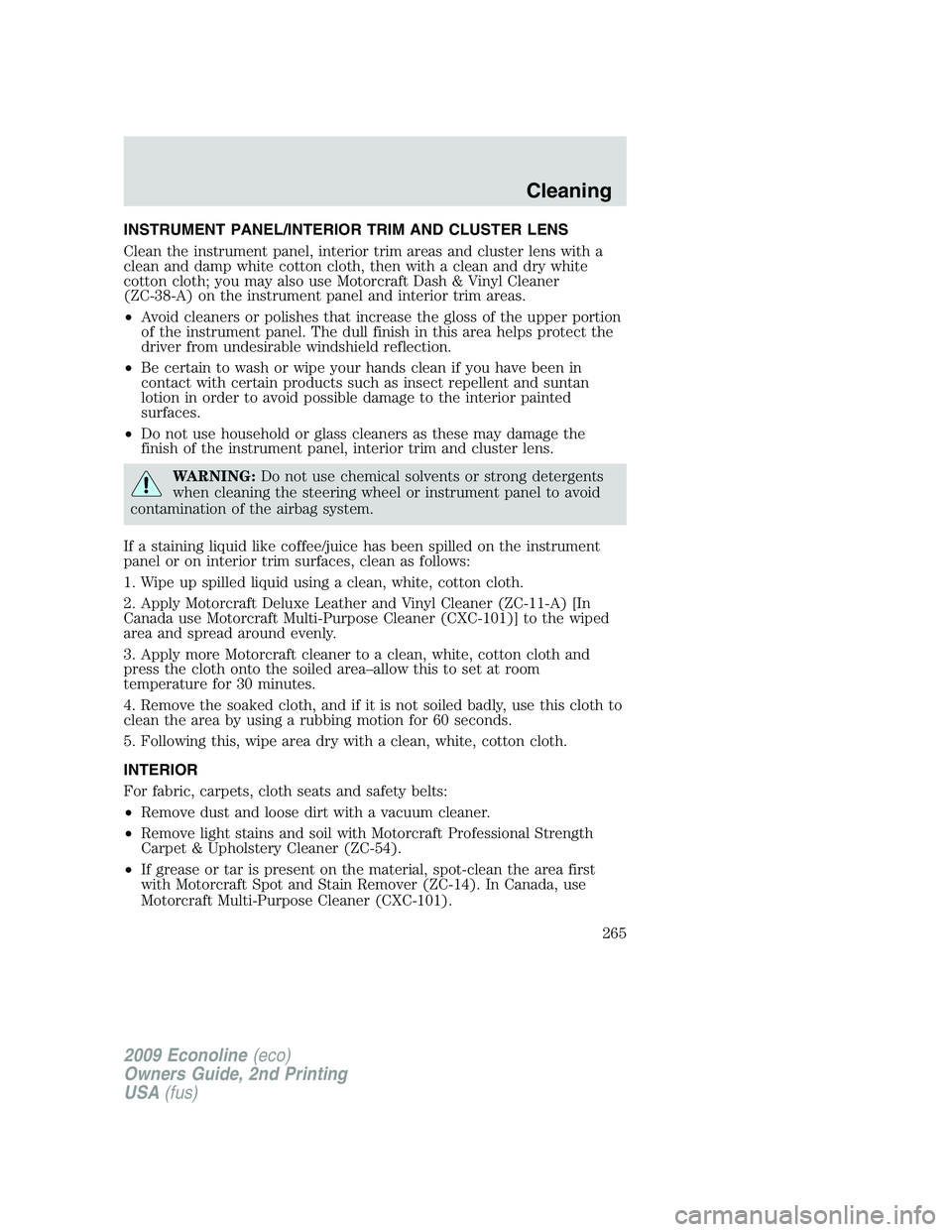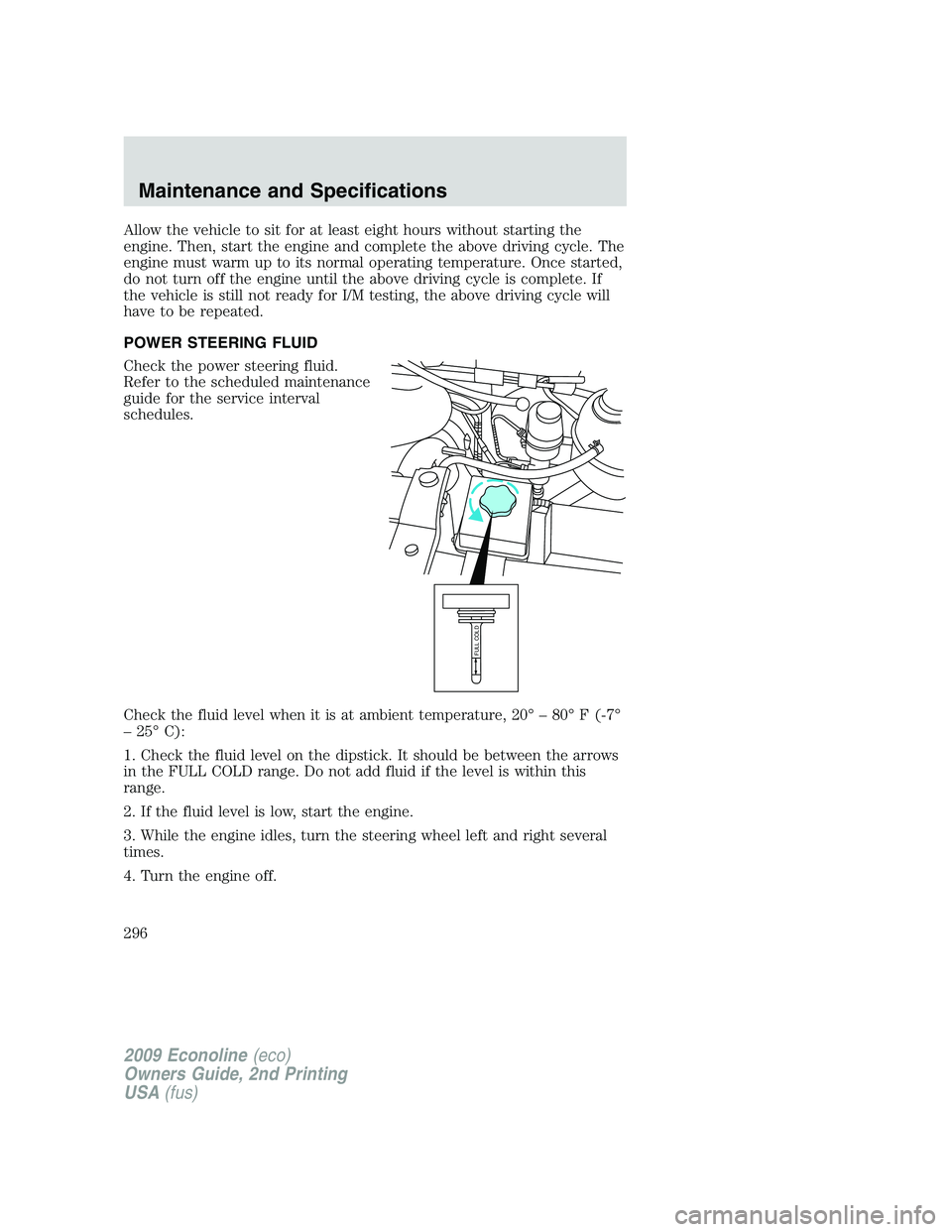Page 265 of 320

INSTRUMENT PANEL/INTERIOR TRIM AND CLUSTER LENS
Clean the instrument panel, interior trim areas and cluster lens with a
clean and damp white cotton cloth, then with a clean and dry white
cotton cloth; you may also use Motorcraft Dash & Vinyl Cleaner
(ZC-38-A) on the instrument panel and interior trim areas.
•Avoid cleaners or polishes that increase the gloss of the upper portion
of the instrument panel. The dull finish in this area helps protect the
driver from undesirable windshield reflection.
•Be certain to wash or wipe your hands clean if you have been in
contact with certain products such as insect repellent and suntan
lotion in order to avoid possible damage to the interior painted
surfaces.
•Do not use household or glass cleaners as these may damage the
finish of the instrument panel, interior trim and cluster lens.
WARNING:Do not use chemical solvents or strong detergents
when cleaning the steering wheel or instrument panel to avoid
contamination of the airbag system.
If a staining liquid like coffee/juice has been spilled on the instrument
panel or on interior trim surfaces, clean as follows:
1. Wipe up spilled liquid using a clean, white, cotton cloth.
2. Apply Motorcraft Deluxe Leather and Vinyl Cleaner (ZC-11-A) [In
Canada use Motorcraft Multi-Purpose Cleaner (CXC-101)] to the wiped
area and spread around evenly.
3. Apply more Motorcraft cleaner to a clean, white, cotton cloth and
press the cloth onto the soiled area–allow this to set at room
temperature for 30 minutes.
4. Remove the soaked cloth, and if it is not soiled badly, use this cloth to
clean the area by using a rubbing motion for 60 seconds.
5. Following this, wipe area dry with a clean, white, cotton cloth.
INTERIOR
For fabric, carpets, cloth seats and safety belts:
•Remove dust and loose dirt with a vacuum cleaner.
•Remove light stains and soil with Motorcraft Professional Strength
Carpet & Upholstery Cleaner (ZC-54).
•If grease or tar is present on the material, spot-clean the area first
with Motorcraft Spot and Stain Remover (ZC-14). In Canada, use
Motorcraft Multi-Purpose Cleaner (CXC-101).
2009 Econoline(eco)
Owners Guide, 2nd Printing
USA(fus)
Cleaning
265
Page 296 of 320

Allow the vehicle to sit for at least eight hours without starting the
engine. Then, start the engine and complete the above driving cycle. The
engine must warm up to its normal operating temperature. Once started,
do not turn off the engine until the above driving cycle is complete. If
the vehicle is still not ready for I/M testing, the above driving cycle will
have to be repeated.
POWER STEERING FLUID
Check the power steering fluid.
Refer to the scheduled maintenance
guide for the service interval
schedules.
Check the fluid level when it is at ambient temperature, 20° – 80° F (-7°
– 25° C):
1. Check the fluid level on the dipstick. It should be between the arrows
in the FULL COLD range. Do not add fluid if the level is within this
range.
2. If the fluid level is low, start the engine.
3. While the engine idles, turn the steering wheel left and right several
times.
4. Turn the engine off.
FULL COLD
2009 Econoline(eco)
Owners Guide, 2nd Printing
USA(fus)
Maintenance and Specifications
296
Page 297 of 320

WARNING:For E-350 and E-450 vehicles with the Hydro-Boost
Brake System, do not press the brake pedal after the engine has
been turned off. Pressing the brake pedal after the engine has been
turned off will give a false power steering fluid level reading.
5. Recheck the fluid level on the dipstick. Do not add fluid if the level is
between the arrows in the FULL COLD range.
6. If the fluid is low, add fluid in small amounts, continuously checking
the level until it reaches the FULL COLD range. Be sure to put the
dipstick back in the reservoir. Refer toMaintenance product
specifications and capacitiesin this chapter for the proper fluid type.
BRAKE FLUID
•E-150/E-350 Single Rear Wheel
•E-350/E-450 Dual Rear Wheel
The fluid level will drop slowly as the brakes wear, and will rise when the
brake components are replaced. Fluid levels between the “MIN” and
“MAX” lines are within the normal operating range; there is no need to
add fluid. If the fluid levels are outside of the normal operating range the
performance of the system could be compromised; seek service from
your authorized dealer immediately.
2009 Econoline(eco)
Owners Guide, 2nd Printing
USA(fus)
Maintenance and Specifications
297
Page 319 of 320

locking/unlocking
doors ..............................80, 85–86
panic alarm ...............................86
replacement/additional
transmitters ...............................87
replacing the batteries .............86
Reverse camera .........................220
Reverse sensing system ...........218
Roadside assistance ..................224
Roll stability control .................201
S
Safety belts (see Safety
restraints) ..........................100–105
Safety defects, reporting ..........260
Safety restraints ................100–105
Belt-Minder�...........................106
extension assembly ................109
for adults .........................101–104
for children .............................120
warning light and chime ........105
Safety restraints - LATCH
anchors ......................................128
Safety seats for children ..........124
Safety Compliance
Certification Label ....................310
Satellite Radio Information ........40
Seats ............................................92
child safety seats ....................124
front seats .................................93
SecuriLock passive anti-theft
system ....................................88, 90
Servicing your vehicle ..............268
Setting the clock
AM/FM single CD .....................25
AM/FM stereo ...........................23AM/FM/In-dash 6 CD ................30
Spare tire
(see Changing the Tire) ...........238
Spark plugs,
specifications .....................304, 309
Special notice ..............................10
ambulance conversions ..............9
diesel-powered vehicles .............8
utility-type vehicles ....................8
Specification chart,
lubricants ...................................305
Speed control ..............................68
Stability system .........................201
Starting a flex fuel vehicle .......195
Starting your vehicle ........193–195
jump starting ..........................245
Steering wheel
tilting .........................................60
T
Temperature control
(see Climate control) ...........44, 46
Tilt steering wheel ......................60
Tire Pressure Monitoring
System (TPMS)
Tires, Wheels and Loading ....160
Tires ...........................142–143, 235
alignment ................................152
care ..........................................148
changing ..................235, 238–240
checking the pressure ............147
inflating ...................................144
label .........................................159
replacing ..........................150, 240
rotating ....................................152
safety practices .......................151
sidewall information ...............154
2009 Econoline(eco)
Owners Guide, 2nd Printing
USA(fus)
Index
319
Page:
< prev 1-8 9-16 17-24